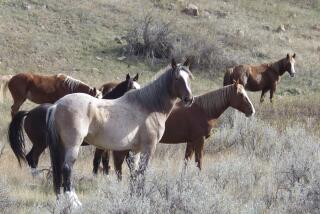U.S. Lifts Longtime Drilling Ban on Alaskan Wildlife Habitat
The Department of Interior on Wednesday approved oil and gas drilling on Alaska land considered such sensitive wildlife habitat that it was first protected by former Interior Secretary James G. Watt under President Reagan, and by four Interior secretaries since.
The decision -- decried by Native American, hunting and environmental groups -- comes just weeks after the U.S. Senate rejected drilling in the Arctic National Wildlife Refuge, about 200 miles to the east.
Bureau of Land Management staff said the decision was made after three years of study and in response to requests by Vice President Dick Cheney’s energy task force.
The plan, signed by Deputy Assistant Interior Secretary Chad Calvert, will open up more than 500,000 acres in and around Teshekpuk Lake on Alaska’s oil-rich North Slope. BLM officials estimate the northeast National Petroleum Reserve, including the lake area, may contain as much as 2 billion barrels of “economically recoverable” oil.
The area is a critical stop for molting geese on the Pacific flyway, with as many as 90,000 birds resting in flat wetlands in the summer. Up to 46,000 caribou also use areas near the lake for calving and migration paths.
Although many Alaskans welcome drilling as an economic boon, some native leaders in the state blasted the decision.
“There are a lot of frustrated people in our community right now,” said Dora Nukapigak, who lives in the small Inupiat Eskimo village of Nuiqsut, at the eastern edge of the reserve, where many people depend on caribou as a food source. “It’s a very sensitive area. It seems like regardless of what we say or do with BLM, they’ll do what they’re going to do anyways, and that’s drill.”
Former Interior Secretary Watt, often derided by environmentalists for other actions, protected more than 200,000 acres of the goose-molting area north of the lake from oil and gas drilling in the early 1980s. His successors under Reagan and President George H.W. Bush maintained those protections. Under President Clinton, Bruce Babbitt expanded bans against drilling around and on the lake to more than half a million acres.
BLM officials acknowledged that the area is important for wildlife and subsistence hunting, and said their plan was “very, very rigorous” in requiring environmental protection and mitigation.
No surface drilling will be allowed on 242,000 acres considered vital for molting geese, or on another 244,000 acres used by caribou. Slant drilling will be allowed under those surfaces from adjoining land. Pipelines must be seven feet high, at least initially, to allow caribou and hunters to pass beneath.
A maximum of 2,100 acres total in seven different zones can be permanently disturbed on the surface, and a three-year study will be conducted of molting geese, BLM staff said.
Leasing of the lands could begin by September, after reviews by a state coastal agency and a regional planning agency, although drilling on the lake will be deferred for 10 years.
“We have done a very good job balancing the subsistence resources while allowing some areas to be opened to oil and gas drilling,” said Susan Childs, energy and mineral planning coordinator for BLM’s Alaska office, which oversees the plan.
“Our mission is to provide for multiple uses. A part of our mission is to protect wildlife, but also part of our mission is to allow for the development of resources. Our job is to find that balance in oil and gas mining,” said BLM Alaska spokeswoman Jody Weil.
But conservation groups blasted the plan and said there were no guarantees the restrictions would remain in place.
“They’re notorious for granting waivers to their own rules,” said Stanley E. Senner, a biologist who is executive director of Audubon Alaska.
“This plan is utterly unbalanced. Even the Reagan administration protected the waterfowl habitat around Teshekpuk Lake because of its world-class ecological and cultural value,” Senner said. “No one should be fooled by the window dressing ... this plan makes every last acre available for oil development.”
Chuck Clusen, director of the Natural Resource Defense Council’s Alaska Project, said the BLM “is supposed to balance all values of our public lands. Giving 100% to the oil industry is not what anyone would call balanced.”
Times Staff Writer Sam Howe Verhovek in Seattle contributed to this report.
More to Read
Sign up for Essential California
The most important California stories and recommendations in your inbox every morning.
You may occasionally receive promotional content from the Los Angeles Times.










